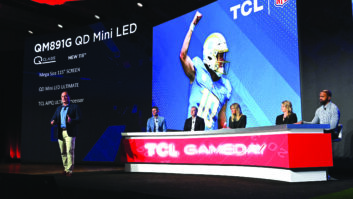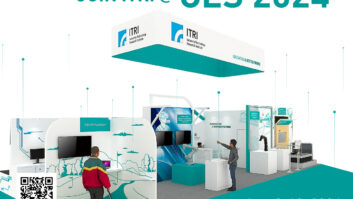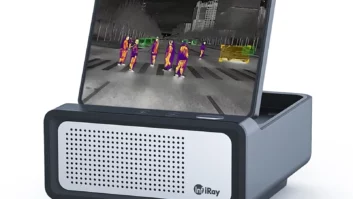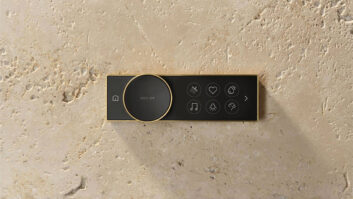A sparkling new consumer electronics product category is on its way. But Mobile DTV demos and product prototypes at the 2009 International CES are just teases. Actual Mobile DTV products won’t be available for sale to consumers until at least this fall.
That doesn’t mean retailers shouldn’t be enticed by the possibilities. Both hardware makers and broadcasters agree: Mobile DTV could be a blockbuster.
“We are big believers in this,” noted John Taylor, LG Electronics public affairs and communications VP, whose company, along with Samsung, is one of the primary developers of the Mobile DTV standard. “We think it’ll be a robust business going forward, provide new revenues for broadcasters, and new product opportunities for consumer electronics manufacturers and our retail partners.”
“It makes television mobile in a way it’s never been done before,” echoed Michael Bergman, Kenwood new digital technologies VP, who is showing a Mobile DTV tuner attachment for the company’s in-car DVD audio/video navigation (AVN) system. “Local stations will finally be made available in digital form to a massive quantity of devices, and has a massive potential for success.”
Mobile DTV is likely to spark a revival in the portable TV business, but unlike other paradigm-setting products such as DVD or digital music players, Mobile DTV isn’t just one device, it’s a wide ranging number of devices, accessories and new two-way TV and data technologies.
“This could bring back the portable TV category,” agreed John Godfrey, Samsung government and public affairs VP, “but it could be a real shot in the arm for backseat video, for navigation traffic data in the front seat, dongles for portable PCs, media players and mobile handsets — all of those categories have potential.”
But what exactly is Mobile DTV? Officially, the name of the Mobile DTV standard is ATSC-M/H (Mobile Handheld), an add-on to standard DTV broadcasts. With a minimal investment, local broadcasters can transmit additional H.264 compressed channels. These channels can be simulcasts of standard broadcast fare, secondary channels, video-on-demand, data streams, advertising designed to be received and displayed by both moving and stationary advertising displays, or whatever else the broadcaster can think of that can generate income.
“The types of content really become limited only by your imagination,” said Mark Aitken, Sinclair Broadcast Group advanced technology director. “It’s the perfect breadboard for trying out different businesses. It’s like throwing spaghetti on the wall — some will stick, some won’t.”
What differentiates Mobile DTV from its portable analog antecedent is its robust nature. It knows you’ll be moving as you’re watching.
With an old analog portable, for example, you had to contort yourself and the antenna to receive even a decent picture. Move an inch, and the picture is gone.
The picture on a Mobile DTV device, however, remains digitally immaculate regardless of how you contort yourself or how fast you’re moving on your feet or in vehicle. As long as you’re within range of the broadcast signal, you’ll get a picture perfect picture.
“We’re creating robust bits that digital hasn’t gone before,” Aitken explained. “It’ll go to that little handheld device, to that antenna on the roof of the car now used for satellite, it’ll deliver robust bits that broadcasters have never before been able to provide.”
Mobile DTV signals are sent out using IP, which means that IP-enabled devices will be able to talk back, enabling video-on-demand. Devices equipped with memory, such as PCs or portable media players, can become Mobile DTV DVRs.
“We first think of the compelling entertainment usage of these devices,” noted LG’s Taylor, “but what’s really important, if not more important, are their ability to receive local content and, therefore, their role in public safety or in a crisis.”
Knowing the potential for Mobile DTV, ATSC put the standard, first proposed just two years ago, on a fast track. “There’s more interest in this than in anything we’ve done,” Mark Richer, ATSC president, observed, “and that includes the basic HDTV standard. People are excited, especially the broadcasters.”
LG will showcase at CES the widest number of Mobile DTV prototypes, including two cellphones — an LG Vu-like handset with a 3-inch touchscreen and a Voyager-like horizontal clamshell with a 2.8-inch dual-touch screen with QWERTY keyboard inside.
LG also will be exhibiting a Mobile DTV digital music player with a 3-inch touch-screen display, a portable DVD player with a widescreen 7-inch LCD, a USB dongle receiver for laptop PCs, and, in conjunction with Hyundai, a Mobile DTV car receiver. LG also will introduce a reference design kit to help other receiver manufacturers develop Mobile DTV devices.
These are all just the tip of the Mobile DTV iceberg, however. “At this show, we’re doing a lot of communication to the industry,” said Kenwood’s Bergman. “It’s a great opportunity for the industry to really make sure everyone gets the message. With tremendous broadcaster support materializing, there’s a great potential for this to be a strong launch later this year.”













